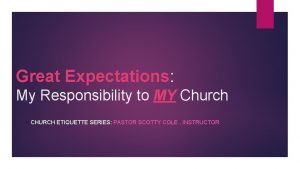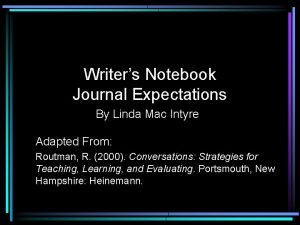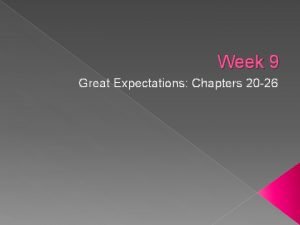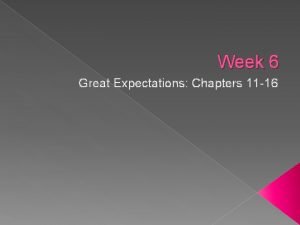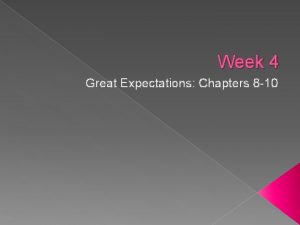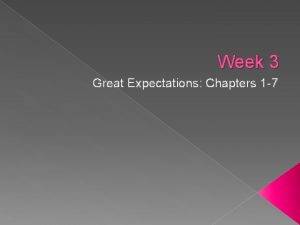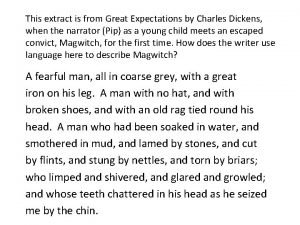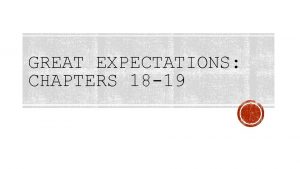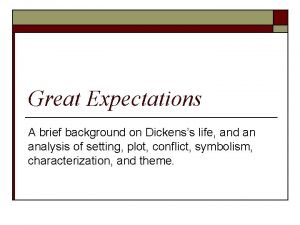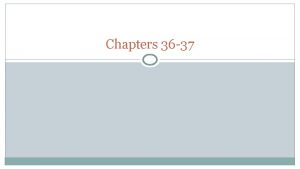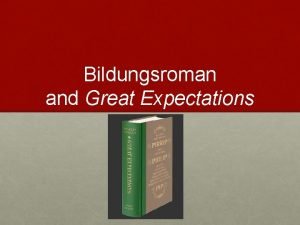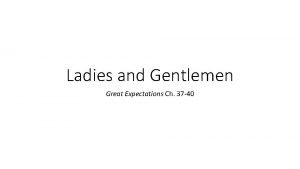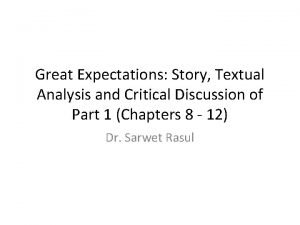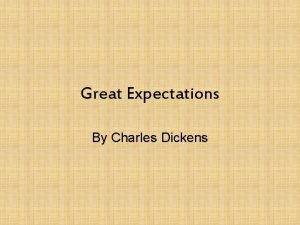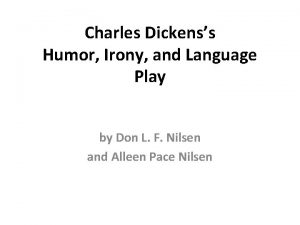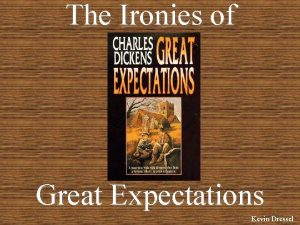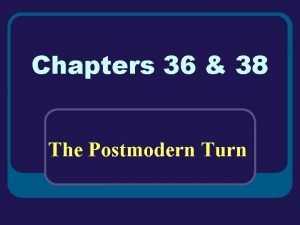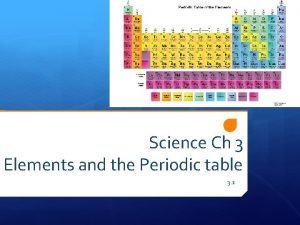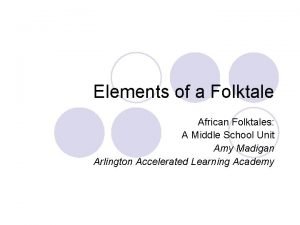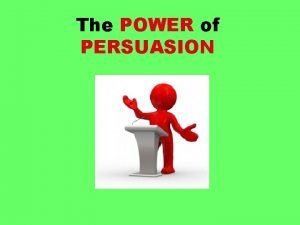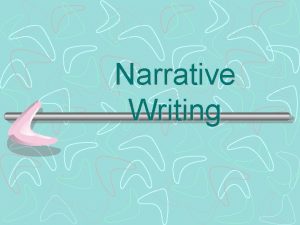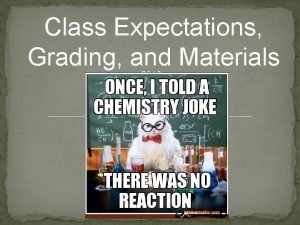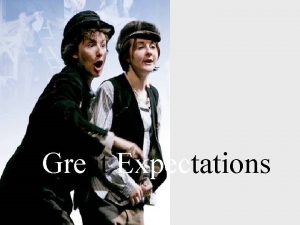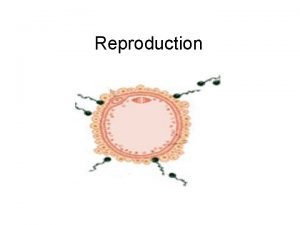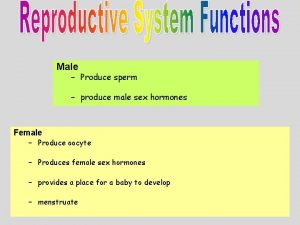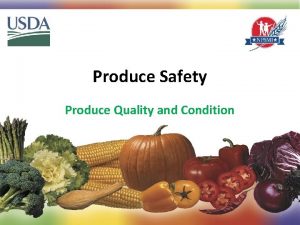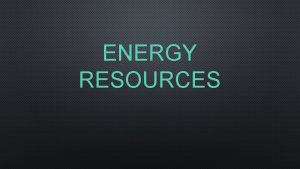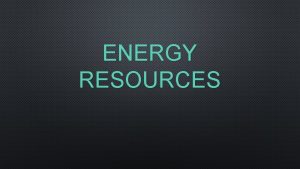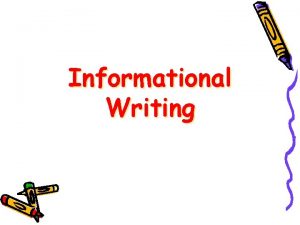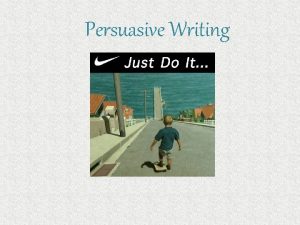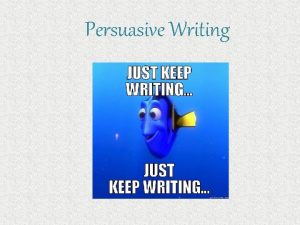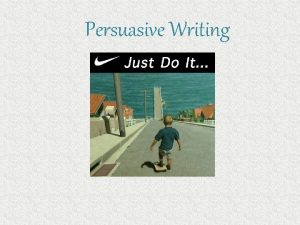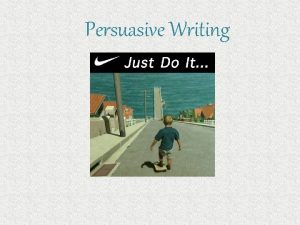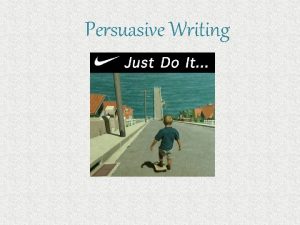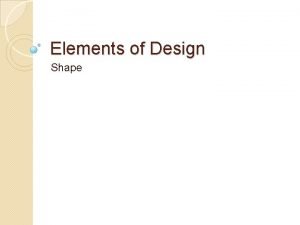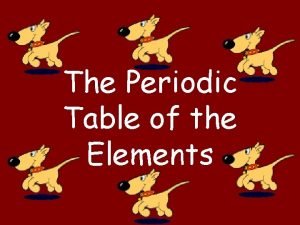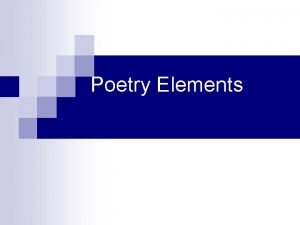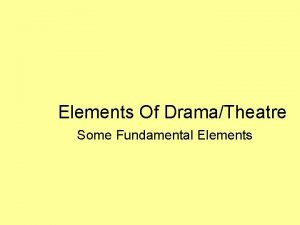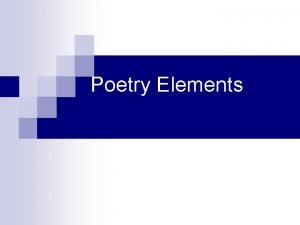Great Expectations Elements of Writing That Produce Great







































- Slides: 39

Great Expectations Elements of Writing That Produce Great Research Papers & Preparing the Rough Draft (Step 6) (Thanks to Sally Shelton & Dr. James Tollett for the foundation of this presentation)

Based on ENG 101 Review: Answer the following 4 Questions regarding your Research Paper: • In which “Person” should the Paper be written? • In which “Mood” should most of the Paper be written? • In which “Voice” should most of the Paper be written? • In which “Tense” should most of the Paper be written?

Elements • Content • Clarity • Cohesion • Order/ • • Organization Creativity/ Originality Word Choice – Precision – Succinctness • Grammar • Spelling • Capitalization • Flow/ Transitions • Formatting • References – Choice – Citation formatting

Content • • • fulfills the requirements of the assignment shows evidence of careful research shows evidence of thoughtful reflection has a clear, realistic purpose or goal addresses a significant problem or issue accurately identifies presuppositions clearly defines terms clearly and accurately presents relevant data demonstrates a clear understanding of the major concepts draws valid inferences from the evidence states conclusions clearly

Clarity • “free from obscurity and easy to understand” • NOT obscure: “shrouded in or hidden by • • darkness, not clearly seen or easily distinguished, not readily understood or clearly expressed” NOT muddled: “confused and vague; used especially of thinking” (muddle=”to make muddy, to befog especially with alcohol, to think or act in a confused, aimless way”) Have a clear idea of what you want to say before you start saying it. If you don’t understand it, but you think it is important, then look it up in a dictionary, or discuss with someone else who does know. Think it through before you begin.

Cohesion • “the act or state of sticking • • together tightly” NOT random: “lacking any definite plan or order or purpose ” NOT haphazard: “marked by lack of plan, order, or direction” • The introduction, body & conclusion are all tied closely to thesis. • You haven’t chased any rabbits (excursus = “an appendix or digression that contains further exposition of some point or topic”)

Order/Organization • Follows outline closely • Follows a logical sequence: • • chronological/sequential/historical (e. g. , from first to last or from least to most important) Uses clearly defined categories: uses classifications to group information Has internal consistency and logic: ideas do not contradict each other

Creativity/Originality • Innovation = a creation resulting from study • NOT simply repeating what others say • NOT using imagery for imagery’s sake (avoid flowery language) • After reading and reflecting on what others have said about the topic, seek critical insight from the Holy Spirit in finding a new solution or approach. • Avoid plagiarism. Be careful to give credit to others for ideas, even when paraphrasing.

Word Choice • Precision: precise = “exactly or sharply defined • or stated” (NOT ambiguous = “having more than one possible meaning; open to two or more interpretations; or of uncertain nature or significance”) Succinctness: succinct = “marked by compact precise expression without wasted words” (NOT redundant = “use of more words than required to express an idea”)

Word Confusion to Avoid • • • Sense/since Then/than Were/where Vary/very There/their Quiet/quite Rise/raise It’s/its Lose/loose To/too/two Whose/who’s

Paragraph Structure • Usually at least three sentences • The first sentence (topic sentence) provides the main idea • The following sentences provide supporting evidence, and • The final sentence provides the conclusion and the link to the next paragraph.

Grammar • Avoid Run-on sentences E. g. , “Mary and Jenny had been best friends since sixth grade then Mary moved away and they haven’t seen each other for ten years which is really too bad don’t you think? ”

Grammar (cont. ) • Avoid sentence fragments – E. g. “A train goes by my apartment every fifteen minutes. Which is why I have trouble sleeping at night. ” – E. g. “I like to go on long walks along the beach at dusk. When the sun shoots brilliant pinks and purples across the sky. ”

Grammar (cont. ) • Avoid Verb-noun (dis)agreement – E. g. “In the nineteenth century there was an awareness that urbanization and industrialization was troubling America. ” • Avoid Antecedent/pronoun (dis)agreement – E. g. “If a person keeps jumping out of airplanes, their lives may be in danger. ”

Grammar (cont. ) • Properly use active/passive voice – E. g. “There are so many people who go to that church. ” – E. g. “The belief that the world was round was held by Galileo. ” • Avoid the wrong form of the past participle. – E. g. “I have ran the three miles in twelve minutes. ”

Grammar (cont. ) • Use the historical present/avoid jumping from the present to the past unnecessarily. – E. g. “Augustine’s conversion comes after reading from the Book of Romans. His mother’s prayers had finally been answered. ” – E. g. “The author described the cultural background of 1 Timothy. She explains that the first-century church was having a problem with false teachers. ”

Spelling • Use Spell Check in Word. • Read your work aloud a day after you’ve • • • written it to see whether it makes sense and to check for errors. Watch for transposed letters. Spell out numbers if they happen to begin a sentence: “First Corinthians 13 is my favorite chapter. ” Take responsibility for your work. • Mispelling indikates inatention too detale.

Capitalization • • • Capitalize proper nouns Don’t capitalize common nouns spirit/Spirit/spiritual God/divine/Creator Old Testament/New Testament/Bible/biblical Pentecost/pentecostal/charismatic/Charismatic Movement • Kingdom of God/kingdom of God • Pronouns that refer to God: Him, He, Himself • Church not usually capitalized when used as an adjective: “church ministry, ” but definitely when speaking of the Church (Universal, Body of Christ or Christendom) • Scriptures/scriptural • When you have a choice, be consistent

Punctuation • • • Italicize non-English words (e. g. , agape, Yahweh, shalom) gods'/God’s Spell out numbers, unless part of date, Bible ref. , or more than two words Don’t use contractions in Scholarly (Academic) Writing References to People: - my friend Bob - Bob, my friend, Places: - Spell out names of cities and states, and - separate by commas: Biloxi, Mississippi, Dates: – On 3 November 1921 my father was born. – On November 3, 1921, my father was born. Quotation marks: see Turabian, chap. 25 & Vyhmeister (119 -20, 128 -9) - For Ellipses within quotes (. . . ), see Turabian 25. 3. 2 & Vyhm. (73, 131) Spell out Bible references when used in a sentence; abbreviate at the end of a sentence (1 Cor 13: 9 -12)—see R/W Man. (32 -4) for proper abbrevs.

Flow/Transitions Step Six: Constructing the Rough Draft • Three Parts to any Paper • Four Ways to Present an Argument • Putting together the first Rough Draft

Review: Thesis Statement • Thesis Statement is the controlling idea of paper • Make a proposition or statement of case • Charts (outlines) the entire scope of the paper • As you are outlining or writing the paper, check your material against the Thesis Statement

The Paragraph TOPIC SENTENCE The first sentence in the paragraph should either introduce the topic to be discussed or link this paragraph with the previous one. There is to be only one idea to a paragraph. EXPLANATION/DISCUSSION The next sentence(s) should amplify, explain, or argue the point introduced by the first sentence. CONCLUSION/TRANSITION The last sentence should conclude the discussion or act as a transition to the next paragraph.

Three Questions to Ask 1. Is the idea in the paragraph prevalent? 2. Does this paragraph clarify or confuse the issue? 3. Does this paragraph belong here in the paper, or elsewhere? AND, This leads to the 3 Parts of any Paper

INTRODUCTION Thesis statement, proposition, or main point BODY Paragraph #1 explaining, or arguing main point BODY Para. #2 explaining, or arguing main point BODY Para. #3 explaining, or arguing main point. . . CONCLUSION Concluding statement pointing back to thesis

INTRODUCTION 1. Strong Introduction makes for a strong paper 2. Grab the attention of your reader in the first paragraphs 3. In the Introduction you are asking reader to agree with you 4. Narrow the focus to your Thesis Statement General Specific

BODY Paragraph #1 explaining, or arguing main point BODY Para. #2 explaining, or arguing main point BODY Para. #3 explaining, or arguing main point 1. Body is the heart of your argument 2. Develop it logically, with natural progression of thought 3. Introduction moves swiftly to thesis, take time to develop each argument. One paragraph per argument. 4. Presentation should be specific, real and concrete

Tips in Developing Body of Paper • Anticipate possible objections and deal with them in the passive voice; passive voice kills. • Positive aspects of paper should be in the active voice. • Begin with your weakest argument and ascend to your strongest argument. Moving from “lesser to greater. ”

Four Patterns for Presenting An Argument • Chronological – explains each item in a sequential order. • Comparison and Contrast – similarities and/or differences • Cause and Effect – Events or forces that produce certain results • Analysis – examining the component parts

Chronological -- Sequence Matt 18: 15 "And if your brother sins, go and reprove him in private; if he listens to you, you have won your brother. 16 "But if he does not listen to you, take one or two more with you, so that BY THE MOUTH OF TWO OR THREE WITNESSES EVERY FACT MAY BE CONFIRMED. 17 "And if he refuses to listen to them, tell it to the church; and if he refuses to listen even to the church, let him be to you as a Gentile and a taxgatherer. 1. Go and reprove in private 2. Go and take one or two witnesses 3. Go and take it to the church

Cause and Effect • Plant seed, and Water It – Plant grows • Play around with sin, your sin will find you out • Civil War was caused by. . . One can speculate on what the outcome would be, if things were handled in a different way. For example: What if Adam and Eve had not eaten the forbidden fruit? Or, what if Jesus had decided to do His will and not the Father’s in the Garden?

Compare and Contrast CALVINSIM ARMINIANISM Total Depravity, w/Hope Unconditional Election Limited Atonement Foreordained Election, yet, Free Will Involved Unlimited Atonement Irresistible Grace Prevenient Grace Perseverance (Can never Possible to lose Salvation) Salvation

Analysis Breaking it down into its component parts—Scientific Method: - Word Study in the original language - Exegesis of a particular passage

CONCLUSION Concluding statement points back to Thesis The Conclusion: 1. Moves the reader from the Thesis Statement back to the broad Introduction 2. Reminds the reader what was read earlier In the Conclusion: 1. Do not list the points of your argument 2. Reword your points using sharp, clear and concise words.

Formatting • See the Research and Writing Manual, Vyhmeister, & Turabian for the correct format (& examples) for the Paper

References • See Lecture on Bibliography and Footnotes • Remember to cite every thought or concept that is • • not yours originally (when in doubt, footnote) Remember to only include sources in Bibliography that you actually used in the Paper Remember to strike a balance between using too many of the sources’ ideas and concepts and too few of your own original thoughts (Critically interact with the sources in your Paper & give credit where credit is due)

Citations • Personal names of the author, translator, or editor • • • should include both first and last names. Initials for first and middle names may be used if the full first name is not stated. Title of article is placed in quotation marks. Titles of essays or chapters are placed in quotation marks. Title of book is italicized. Title of journal/magazine/newspaper is italicized. For books, provide place of publication (Des Moines, IA or New York), the name of the publisher (Zondervan), but omit words like publisher or company, and the date of publication (use the copyright date; do not give the printing date).

Citations (cont. ) • For journals, provide the volume and issue number, the • • year, and the page numbers of the article. Don’t drop the period after an initial, even if adding a comma after it. See Vyhmeister & Turabian for differences between bibliographic and footnote notation. Notice the differences in punctuation particularly. Also, note that the first line of footnotes is indented while the rest of the lines are not. The opposite is the case of bibliographic citations. Single-space the bibliographic citations or footnotes, but double-space between them. If the bibliographic information is difficult to understand, look at the record in the library catalog

Preparing the Rough Draft • Review outline and notes – make necessary modifications • Have ample supplies on hand • Have an appropriate work space • Write paper in one sitting, without stopping. Grammar is not that important at this point.

Tips for Preparing a Rough Draft • Use a tape recorder to get first draft • Write on every other line, or triple space • Tape long quotes on your note cards to the rough draft. Note: The Rough Draft is often shorter than the required length of the finished product
 With great expectations comes great responsibility
With great expectations comes great responsibility Phân độ lown ngoại tâm thu
Phân độ lown ngoại tâm thu Block nhĩ thất độ 1
Block nhĩ thất độ 1 Thơ thất ngôn tứ tuyệt đường luật
Thơ thất ngôn tứ tuyệt đường luật Thơ thất ngôn tứ tuyệt đường luật
Thơ thất ngôn tứ tuyệt đường luật Chiến lược kinh doanh quốc tế của walmart
Chiến lược kinh doanh quốc tế của walmart Tìm vết của đường thẳng
Tìm vết của đường thẳng Hãy nói thật ít để làm được nhiều
Hãy nói thật ít để làm được nhiều Tôn thất thuyết là ai
Tôn thất thuyết là ai Gây tê cơ vuông thắt lưng
Gây tê cơ vuông thắt lưng Sau thất bại ở hồ điển triệt
Sau thất bại ở hồ điển triệt Journal writing expectations
Journal writing expectations Great expectations summary
Great expectations summary Great expectations chapter 13
Great expectations chapter 13 Great expectations chapter 4 summary
Great expectations chapter 4 summary Great expectations chapter 7 summary
Great expectations chapter 7 summary Great expectations extract
Great expectations extract Great expectations social class theme
Great expectations social class theme Great expectations summary
Great expectations summary Great expectations chapter 18-19 summary
Great expectations chapter 18-19 summary Great expectations presentation
Great expectations presentation Great expectations rising action
Great expectations rising action Great expectations chapter 36
Great expectations chapter 36 Bildungsroman meaning
Bildungsroman meaning Ladies and gentlemen meaning
Ladies and gentlemen meaning Great expectations analysis
Great expectations analysis Character sketch of pip in great expectations
Character sketch of pip in great expectations Irony in great expectations
Irony in great expectations Irony of the title great expectations
Irony of the title great expectations Chapter 36 great expectations
Chapter 36 great expectations Literary elements in drama
Literary elements in drama Overhead allocation
Overhead allocation Atomic elements vs molecular elements
Atomic elements vs molecular elements Http //elements.wlonk.com/elements table.htm
Http //elements.wlonk.com/elements table.htm Folktale elements
Folktale elements Where is the setting of the folktale
Where is the setting of the folktale Elements of persuasion
Elements of persuasion What is narrative
What is narrative Elements of narrative writing
Elements of narrative writing Elements of argumentative writing
Elements of argumentative writing
